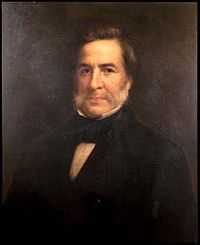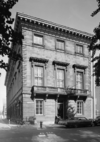John Notman

John Notman (1810—1865) was a Scottish-born American architect, who settled in Philadelphia, Pennsylvania. He is remembered for his churches, and for popularizing the Italianate style and the use of brownstone.
Career
He was born in Scotland and educated at the Royal Scottish Academy. Notman worked in the office of William Henry Playfair in Edinburgh prior to emigrating to the United States in 1831. He eventually settled in Philadelphia, Pennsylvania, where one of his first commissions was Laurel Hill Cemetery in 1835.[1] He later opened and operated a successful firm until his death in 1865. Notman was also a founding member of the American Institute of Architects and was committed to establishing professionalism in the practice of architecture in the United States.
Notman is credited with introducing the Italianate style to America. "Riverside", his 1837-39 house in Burlington, NJ for Bishop G.W. Doane, was tremendously influential, and his 1845 Athenaeum of Philadelphia was the first Italianate building in his adopted city.[2] Notman designed a number of suburban villas and country houses, including "Ogontz" (1863) for financier Jay Cooke.
Many of his designs for churches were dictated by the ideas of the Cambridge Camden Society who suggested that Anglican churches of the Low church variety should be built in the Romanesque style, while those of the High church variety be built in the Gothic style. He was also briefly employed by the Roman Catholic Diocese of Philadelphia during construction of the Cathedral Basilica of Saints Peter and Paul until an argument over the terms of his contract resulted in his dismissal.
Notman was also the architect of the highly influential New Jersey State Lunatic Asylum in Trenton New Jersey of 1847. This building was the first example of the Kirkbride Plan in asylum design.[3]
Following Notman's death, the firm continued for a couple years under his protege George Hewitt.
Churches
%2C_1625_Locust_Street%2C_Philadelphia_(Philadelphia_County%2C_Pennsylvania).jpg)
Some of Notman's notable commissions for the Episcopal Church include:
- Chapel of the Holy Innocents, Saint Mary's Hall, Burlington, NJ (1845).
- St. Thomas Episcopal Church, Glassboro, NJ (1846).
- St. Paul's Episcopal Church, Trenton, NJ (1848). Attributed to Notman.
- St. Mark's Church, 1625 Locust Street, Philadelphia, PA (1849). Tower completed by George Hewitt (1865). Lady Chapel by Cope & Stewardson (1899-1902).
- Emmanuel Church, Cumberland, MD (1851).
- St. Peter's Church, Pittsburgh, PA (1851).
- St. Clement's Church, Philadelphia, PA (1855–59).
- Church of the Holy Trinity, Rittenhouse Square, Philadelphia, PA (1856–59).
- St. John's Episcopal Church, Wilmington, DE (1857-1858); located in the Brandywine Village Historic District.
- Cathedral Church of St. John the Evangelist, Concord Ave. & Market St., Wilmington, DE (1858).
Gallery
-
_HABS314296cv.jpg)
Laurel Hill Cemetery Gatehouse, 3822 Ridge Ave., Philadelphia, PA (1835).
-

Athenaeum of Philadelphia, 219 S. 6th St., Philadelphia, PA (1845).
-

Athenaeum of Philadelphia, stair hall.
-
Church of the Holy Trinity, Rittenhouse Square, Philadelphia, PA (1856–59).
Further reading
- Constance M. Greiff, John Notman Architect, 1810-1865. Philadelphia: Athenaeum of Philadelphia, 1979.
- Carla Yanni, The Architecture of Madness: Insane Asylums in the United States, University of Minnesota Press, 2007.
References
- ↑ "General View of Laurel Hill Cemetery". World Digital Library. Retrieved February 14, 2013.
- ↑ Francis Morrone, An Architectural Guidebook to Philadelphia (Layton, UT: Gibbs Smith, 1999), p. 153.
- ↑ Yanni, Architecture of Madness, 52-59.
External links
|
